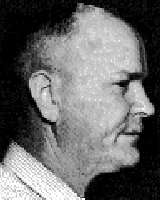Euday L. Bowman
Euday Louis Bowman (November 9, 1887 – May 26, 1949) was an American pianist and composer of ragtime and blues who represented the style of Texas Ragtime. He is chiefly remembered as the composer of the successful Twelfth Street Rag, a rag from 1914 out of a series of ragtimes that Bowman wrote during or after a period in which he worked as a pianist in some of the better bordellos of Kansas City. These tunes -- "Sixth Street Rag", "Tenth Street Rag", "Eleventh Street Rag" and "Twelfth Street Rag"—were named after streets of "Boss" Tom Pendergast's redlight district.
Euday Louis Bowman | |
|---|---|
 | |
| Background information | |
| Born | November 9, 1887[1] Fort Worth, Texas[1] |
| Died | May 26, 1949 (aged 61)[1] New York, New York[1] |
| Genres | Ragtime |
| Occupation(s) | Composer, performer |
| Instruments | Piano |
Biography
Euday Bowman was born and lived in Tarrant County, TX. The area, originally named Bowman Springs after his grandfather, was renamed Webb around 1895, and is now a suburb of Fort Worth. His parents divorced when he was young and his mother moved the family to Fort Worth. Both his mother and sister were piano teachers.
Much of what is thought to be known about Euday is based on writings of Brun Campbell and there are significant errors. He is the source of the only known photo of Euday. It appears to be a mugshot and is of questionable authenticity. He did not lose a leg and he did not die without heirs. In fact, when Brun wrote that, 24 claimants were involved in a lawsuit establishing the legitimate heirs.
Although many sources indicate Euday lost a leg when he tried to hop a train, that event happened to his cousin and resulted in a lawsuit ultimately decided by the Texas Supreme Court.[2]
In his teens and early twenties, Bowman traveled around as pianist. Bowman was also an arranger for popular orchestras. He lived together with his sister, Miss Mary M. Bowman, who wrote a part of Twelfth Street Rag. Bowman sold the copyright to the song for just $100. Many years later he regained the copyright, having lost out on the royalties earned by the publisher through the many successful interpretations of that rag by artists like Louis Armstrong (1927), Bennie Moten (1927), Duke Ellington (1931), and Pee Wee Hunt (1948). Other works of his include Petticoat Lane Rag, Colorado Blues, Kansas City Blues, Fort Worth Blues, Tipperary Blues, Shamrock Rag, White Lily Dreams, and Old Glory On Its Way.
Claim of Royalties
Euday had no children, so the royalties went to his sister. Upon her death one year later, Ed G. Max was appointed temporary administrator for her estate. His siblings, Charlotte Goldman and husband and Harry Loyd Max, filed their opposition to Mary Bowman's will, and alleged that they, with Ed G. Max, their brother, were nephews and niece of Mary M. Bowman and were all and the only heirs to her estate. An intervention was filed by Forrest Campbell and twenty-one others, asserting they were cousins of Mary M. Bowman, and children of deceased cousins of Mary M. Bowman, and were the only heirs of deceased Mary M. Bowman. The cousins ultimately prevailed.
Euday Bowman's work is not public domain. Royalties remained distributed among hundreds of descendants of the cousins until 2013, when two descendants bought out the others via private auction.[3]
See also
References
- Jasen, David A.; Trebor Jay Tichenor (1978). Rags and Ragtime: A Musical History. New York, NY: Dover Publications, Inc. p. 49. ISBN 0-486-25922-6.
- Galveston Harrisburg San Antonio Railway v V.F. Zantzinger, 92 Tex. 365 (Tex. 1898)
- "GOLDMAN ET AL. v. CAMPBELL ET AL. (05/09/52)". tx.findacase.com.
External links
Note: Brun Campbell is often cited as an authority on Euday Bowman. He is no relation to Euday's Campbell cousins, and his account of Euday's life differs significantly from the Campbell family stories.